Forums:
Some martagons recently or currently in bloom here:
A couple of really lovely ones given to me by my friend from work, Adam, who is very active in growing and hybridizing lilies and is becoming well known in lily circles... These flower stalks are 6' 5 1/2' tall this year.
[Sorry, there used to be pictures here, but the link is broken. Lori]

Comments
Richard T. Rodich
Re: Lilies, anyone?
Sat, 07/30/2011 - 3:59pmA very nice one, Lori. A little bit similar to a very old martagon section cultivar, Mrs. R.O. Backhouse. A cross of Lilium martagon and the yellow Lilium hansonii, it is still one of my all time favorite lilies.
21 Jun 2011
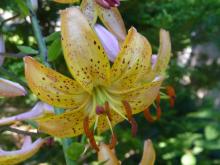
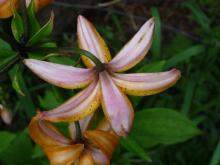
I have recently come out of the dark ages from a dial up connection to DSL, my only other option (unless I am willing to pay $700+/year). Still, a huge difference as with dial up even the thumbnails didn't always fully load. So I have been going through my many lily pics in preparation for such a thread as this, and since Lori has started the topic of same, there's no better time than the present to begin.
In my garden, this is the first year ever that a martagon lily has beat out my Lilium szovitsianum for the coveted "first bloom of the year award" - by two days. First to bloom were two martagons grown from seed, nicely spotted pink ones, although nothing spectacular about them. Then came Lilium szovitsianum. First bloomed in 2008 its seventh year from seed, it is usually a reliable performer, despite the fact that it grows in full sun through the hot humid summers here. But this season's 100 F temps in June produced some super compacted flower spikes that were not very comely, although flowers were normal. From year 2010:
It doesn't show too well in the photos, but the foliage is decidedly unlily-like in the traditional sense. So much so that when a learned friend came over and saw the one foot sprouts, he exclaimed "What is that?"
16 May 2011 May 2010
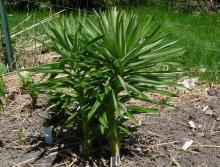

The maroon accents at the base and end of each petal is quite fetching.
Jun 2009 30 May 2010
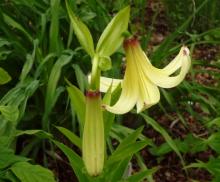
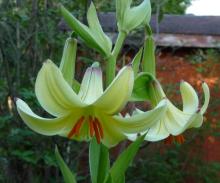
Lori S. (not verified)
Re: Lilies, anyone?
Sat, 07/30/2011 - 7:10pmExcellent news, Rick! We await your postings with bated breath. :)
Richard T. Rodich
Re: Lilies, anyone?
Sun, 07/31/2011 - 11:07pmMore martagon seedlings. This is one that beat out szovitsianum for first bloom of the season:
1 Jun 2011

Other nice variations. Notice the bit of "nectary" marking on the second one.
30 Jun 2011 9 Jun 2011

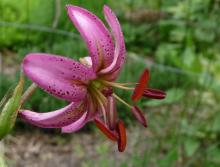
Most lilies are self infertile, including martagons. So to obtain Lilium martagon var. album seed (for instance), one must cross too genetically different plants of that same variety. Most gardeners don't seem to realize this. Consequently much of the seed in seed exchanges for var. album is really martagon album x martagon not album, because most gardeners don't have two different Lilium martagon var. album, and/or don't bother to hand pollinate. I have tried three different batches of seed of supposedly Lilium martagon var. album, and none have yielded the true variety. I do come up with some nice crosses, though:
25 Jun 2011

25 Jun 2011 25 Jun 2011
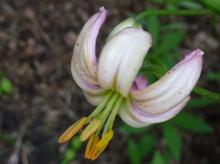
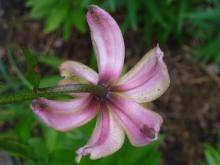
20 Jun 2011 20 Jun 2011
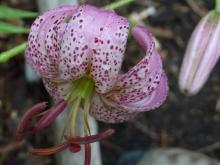
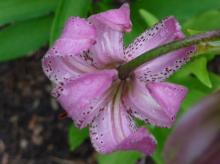
I do have one nice white seedling, but I know that its was produced from crossing a white martagon with a gold.
27 Jun 2011
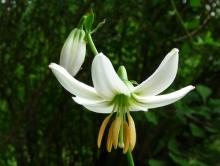
Cliff Booker
Re: Lilies, anyone?
Mon, 08/01/2011 - 5:19amHi Rick,
Thought you might be interested to see these two images captured in the Dolomites in July this year of the only example of a white Lilium martagon we have ever seen on our numerous visits?
Richard T. Rodich
Re: Lilies, anyone?
Mon, 08/01/2011 - 8:42amYes, thank you Cliff. And a very tight inflorescense. Is that predominant among all the martagons in the Dolomites?
Lori S. (not verified)
Re: Lilies, anyone?
Mon, 08/01/2011 - 1:23pmA few more...
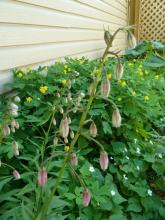
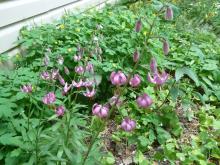
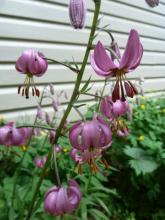
A form of Lilium martagon with very furry buds and small (~3cm across), highly recurved flowers:
Lilium martagon 'Album'... not, unfortunately, in such a beautiful setting as Cliff's! :)
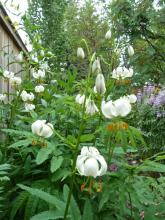
Lilium xdalhansonii:
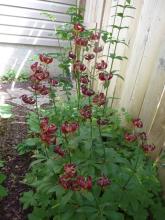
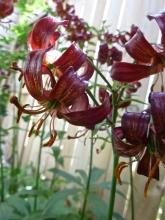
L. martagon 'Pink Attraction':
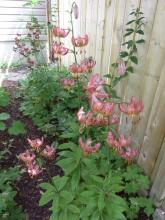
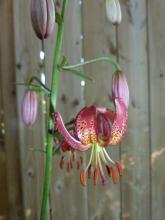

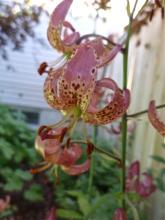
Lori S. (not verified)
Re: Lilies, anyone?
Mon, 08/01/2011 - 1:32pmUnknown martagon that was ravaged by lily beetles this spring, yet somehow managed to bloom a little... any thoughts on which it is?
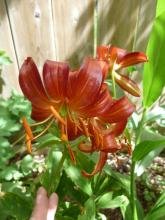
L. martagon 'Early Bird':

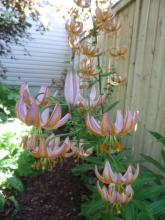
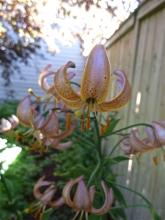
L. martagon 'Amelita':
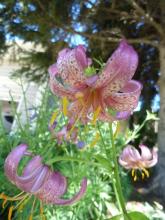
Tony Willis (not verified)
Re: Lilies, anyone?
Mon, 08/01/2011 - 1:47pmSorry I did not realise there was a lily thread when I posted my photographs in the bulb section. Lori and Rick some truly outstanding forms of martagon.
Here is my Lilium martagon ssp cattaniae from Greece. The lily foliage on the left is L. chalcedonicum before it moved into bud
Lori S. (not verified)
Re: Lilies, anyone?
Mon, 08/01/2011 - 2:55pmNo matter, Tony. (I forgot that there were some lily photos in the other thread... I could/should have posted there but no worries either way. :) )
That is absolutely fabulous!! What a colour! Ssp. cattaniae has very furry buds, doesn't it?
Tony Willis (not verified)
Re: Lilies, anyone?
Mon, 08/01/2011 - 3:27pmLori
yes ssp cattaniae does have very furry buds which are quite fascinating as they develop. I collected the plants as single scales on Mt Falackro in NE Greece and have since done the same thing on Mt Kymachalan further west but these have yet to flower.
Lori S. (not verified)
Re: Lilies, anyone?
Mon, 08/01/2011 - 6:32pmHow long does it take from scaling a bulb to blooming size?
Mark McDonough
Re: Lilies, anyone?
Mon, 08/01/2011 - 7:02pmNo time to respond, except to say that I'M REALLY ENJOYING THESE MARVELOUS LILIES, they're all so gorgeous. I have such a problem with lily beetle, that I stopped considering the genus, but a friend tells me that the summer blooming species like L. martagon are less bothered by the pests, is that true?
Lori S. (not verified)
Re: Lilies, anyone?
Mon, 08/01/2011 - 7:24pmSo far, in my limited experience with lily beetles (which is only over 3 years now... and already I hate them with a passion!), it seems they are somewhat less attracted to martagons than to asiatic hybrids. However, I'm sure someone with experience local to your zone/area will be able to give some more relevant commentary.
Richard T. Rodich
Re: Lilies, anyone?
Mon, 08/01/2011 - 10:51pmLori, that small furry bud martagon has some really narrow foliage for a martagon. Love the diversity. All of my martagons have wider leaves to some degree. This one has the "best" foliage:
27 Jun 2011
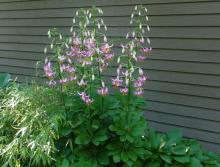
Tony, your subspecies cattaniae are very special (and beautiful!). What time of year did you harvest scales?
Mark, martagons may be summer blooming, but they are in general among the earliest of the genus. Don't let the timing of this thread mess you up: while Lori's martagons might be concurrent, mine are not (and are long gone). I've edited dates in for my previous photos.
The lily beetle has not arrived in Minnesota ... yet.
Tony Willis (not verified)
Re: Lilies, anyone?
Tue, 08/02/2011 - 2:46amRick
I collected the scales the first week in May which is when I know I was in Greece and can therefore be accurate about the timing.
However below are two martagons I purchased late November last year and before planting I took some scales of the bulbs and have got new plants from them.
I do not think it matters when you do it ,just when the material is available and the only difference is the time when the new bulbil produces its first leaf.
The 'albiflorum' is not one I was really taken with but the 'red russian' is really beautiful.
I also have Lilium polyphyllum which I grew from seed. This flowered for the first time this year and appears to have set seed.
Richard T. Rodich
Re: Lilies, anyone?
Tue, 08/02/2011 - 8:05amI have read that with certain species, timing is import for successful scaling: L. szovitsianum to be exact, which is why I ask. Supposedly, scales removed in the fall yielded no bulblets, while those taken in summer, especially right after bloom, produced many bulblets.
Nice photos. I have seen pics of albiflorum with fewer spots, and I think I like those better, although yours is nothing to scoff at! Lilium polyphyllum is indeed a great find! (And from seed, too. Congratulations!)
Richard T. Rodich
Re: Lilies, anyone?
Tue, 08/02/2011 - 9:45amMore martagon cultivars:
Claude Shride (a Minnesota introduction) usually has a few spots on each flower. I must have twenty bulbs of this vigorous clone, and this year none have spots at all!
16 Jun 2011

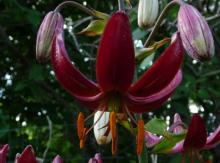
Also this year, the white striping on the back is very prominent. I noticed this on one of your lilies, too, Lori.
Terrace City

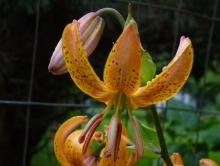
23 Jun 2011
Lilium taliense "var. kaichen"
I only have one and the species is self infertile. I hand pollenated almost every flower with pollen from various species and hybrids, but the only pollen it has accepted to date is Lilium lijiangense and Lilium duchartrei.
24 Jun 2011
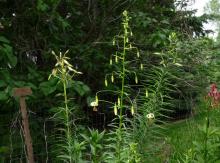
2 Jul 2011
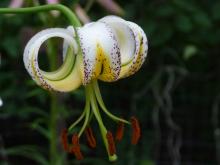
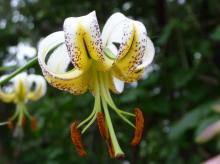
Tony Willis (not verified)
Re: Lilies, anyone?
Tue, 08/02/2011 - 12:27pmRick
I have never grown any of the Turkish lilies or indeed on my nineteen trips there actually seen one in the wild always being too early and therefore have no experience with scaling them. I hope to start growing some in the near future.
The Claude Schride is very nice and from your pictures appears to be very close to Red Russian which in the flesh is stunning.
I have a number of the Chinese ones coming on that I have imported and on the whole the names are wrong and since most have not flowered yet I do not have an identification.
killdawabbit (not verified)
Re: Lilies, anyone?
Tue, 08/02/2011 - 1:28pmI love the pics, everyone. Now I'm dying to try some martagons. I only have a few common varieties so far.
Cliff Booker
Re: Lilies, anyone?
Tue, 08/02/2011 - 11:59pmThe beautiful, but always slightly incongruous, Lilium bulbiferum thriving at Val Gardena in the Dolomites. July 2011.
Lori S. (not verified)
Re: Lilies, anyone?
Thu, 08/04/2011 - 2:33pmBeautiful indeed! It does seem slightly incongruous to see a lily up there... but my viewpoint is of only one native lily (L. philadelphicum), that tends to inhabit the mixed forest edge.
Trond Hoy
Re: Lilies, anyone?
Fri, 08/05/2011 - 1:36pmI fully agree with your first statement. However, your second is wrong: It is not me but my lilies which are dying :'( . . not beetles but slugs.
Richard T. Rodich
Re: Lilies, anyone?
Mon, 08/08/2011 - 8:16pmLilium distichum
From Korea and nearby China, this is the area where the four other Lily species (besides L. martagon) that make up the martagon section of the genus grow. Even as species lilies, most are fairly rare in cultivation. I have found L. distichum easy to grow, but I would venture that to most people it's not the prettiest lily around. I only have one clone blooming, so I can't make blanket assessments of the species, but on this one, I really like the black stems, and stark white ovary. Like L. tsingtauense, the petals possess the deepest saturation of orange, and at least on this L. distichum, the petals are even glossier.
25 Jun 2011

Richard T. Rodich
Re: Lilies, anyone?
Mon, 08/08/2011 - 8:23pmThis is what many (at least in the U.S.) think of as Lilium tsingtauense. It's ancestry dates back to the early collections of lilies in Korea and/or nearby parts of China. But actually, these photos are of a natural cross of Lilium tsingtauense and Lilium distichum (and/or Lilium medeoloides). Lilium tsingtauense bears completely upfacing flowers and ruffly foliage. Ll. distichum and medeoloides have outfacing flowers and leaves without rippling.
There are some that label this a separate species, L. miquelianum, but it is generally not an accepted name. However I do use the designation for simplicity's sake, as a shorthand for the uncertain cross.
16 May 2011
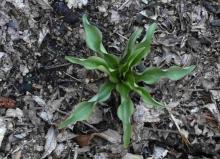

Late May 2009
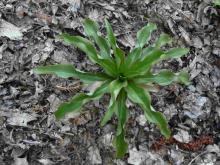

How the petals radiate seems dependent on the position relative to gravity. These are the two extremes:
28 Jun 2011
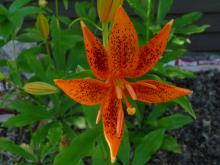
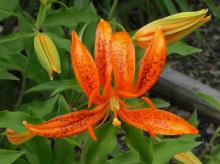
This natural hybrid has the undesirable characteristic of skipping a season of growth for whatever reason. Last year, I thought my clump was dwindling, since it only had four stems in 2010. When I dug them that fall, I discovered many bulbs had just taken the year off, and were as healthy as could be. Now I have quite a few...
Tony Willis (not verified)
Re: Lilies, anyone?
Tue, 08/09/2011 - 1:30amRick thanks for a most interesting post.
I am growing Lilium tsingtauense from scales which came from a recent importation and so I have some way to go before I see it flower. I must confess I am not at all keen on upward facing lilies but it was offered and I thought I would give it a go.
As to L. distichum I saw this at the Tatton Park Flower Show last year and it was superb,brick red outward facing perfectly formed flowers and I have now obtained what I think is hopefully a plant from China. This produced a rosette of leaves and has no died down.
You mention the hybrid skipping a season and in fact my L. gloriosoides has not put any growth above ground for three seasons. It is a beautiful healthy bulb and makes new roots each year. I am going to keep it frost free over the coming winter and see if this will bring it into growth.
Here are two pictures of my second L. poilanei in flower. I am working hard on getting seed.
Richard T. Rodich
Re: Lilies, anyone?
Tue, 08/09/2011 - 8:28pmI very much enjoy your Lilium poilanei. I wouldn't be surprised if it would be hardy for you outside, if you can keep it dry enough. Not that you should try... I'm just sayin'.
My L. distichum does have a hint of red in it. I will be transplanting it to a not full sun area this fall. Perhaps then it will show deeper color. I, too, much prefer the out and down facing flower orientation over upfacing. But a bit of a mix is nice, especially if they are species.
This is good to know! I have two tiny bulblets from seed (germinated this past winter) of var. gloriosoides. I hope they don't exhibit that trait early in life...
We will all be interested to see if you find the trigger for seasonal growth. I follow everything Lilium on the SRGC forum, too.
Years ago, I received a bulb of Lilium speciosum var. gloriosoides from Chen Yi. The bloom was the highlight of the year. I tried to overwinter the bulb in the pot in the refrigerator, but was unsuccessful.
Sept 2007
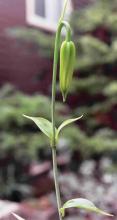
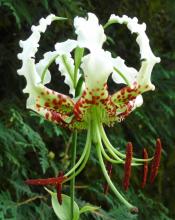
Richard T. Rodich
Re: Lilies, anyone?
Wed, 08/10/2011 - 5:19pmNext to flower this year is Lilium concolor. Variety coridion consistently blooms at least a few days earlier than variety strictum for me, but there is always overlap. Both are small flowered (3 inches) and very narrow growing plants, although strictum is even more narrow. There can never be the excuse for "no room in the garden" for these. They will fit anywhere, are are easy from seed, and bloom in the second year. Red-orange is the "normal" color for the species, spotted or unspotted. The nubs on the petal ends seem to be a trait of the species.
Lilium concolor var. coridion 7 Jul 2001
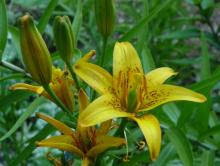
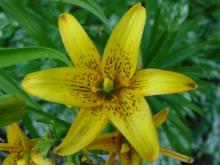
Lilium concolor var. strictum 12 Jul 2011
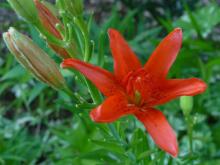

Richard T. Rodich
Re: Lilies, anyone?
Wed, 08/10/2011 - 6:17pmOops, I neglected Ll. duchartrei and lankongense :rolleyes:. They began blooming the first few days of July. Both are similar to L. fargesii in that these species can easily bloom with small, 2-3 inch flowers or larger 4+ inch flowers, depending on the vigor and/or siting of the plant. (My first bloom ever of L. fargesii was only one inch wide. Now they bloom more than double that size.)
Lilium duchartrei. When in bud, the white is almost as saturated as in the Madonna lily (L. candidum). I have one that has a bronze/maroon coloring at the base and tips of the petals (similar to Caucasian lilies), mostly visible in bud, and two with green coloring.
Lilium duchartrei - (green coloring)
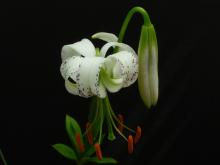
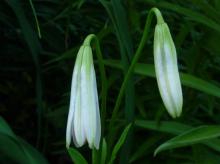
Lilium lankongense
Stephen Barstow
Re: Lilies, anyone?
Thu, 08/11/2011 - 12:21amA couple flowering in the garden here at the moment:
1) Lilium callosum
2) Lilium lancifolium flaviflorum with Mondarda didyma "Adam" and Monarda fistulosum v. menthifolia
Richard T. Rodich
Re: Lilies, anyone?
Thu, 08/11/2011 - 9:14pmStephen, a wonderful Lilium callosum, indeed!
I have seedlings of the species, from seed collected in Russian Far East: Kedrovaja Padj. Planted in 2009, the seeds sprouted within 15 days and seemed fairly weak, producing only one long leaf per seedling. The 2010 season showed a few leaves per plant. But now in 2011, they have exploded in growth. Had I known of this ensuing growth, I would have transplanted them into bigger pots!
But early in the year I was becoming very disappointed, since the stems seemed to closely resemble L. concolor var. strictum. I figured the seed identity had gotten mixed up. Even as tiny buds began to appear on these little plants, I was not impressed. Blooming at this size is not unusual for the concolor species. But as the buds began to tip and take their natural pendant position, my heart was lifted. Yes, these are in fact the real thing!
It should be noted that these pics are not very indicative of the true species habit. Eleven of them are growing in a small 3.5 x 3.5 x 5 inch pot. Surely, this is not normal! That would be Stephen's photo above. (Thanks for posting, Stephen.)
Lilium callosum seedlings
10 Jul 2011 16 Jul 2011
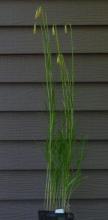
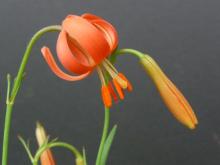
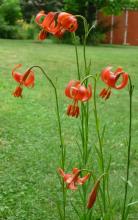
Richard T. Rodich
Re: Lilies, anyone?
Fri, 08/12/2011 - 7:31pmI received Lilium maculatum var. wilsonii in 2006 as bulbs from the SLPG (Species Lily Preservation Group). It is an upfacing lily with very shiny foliage. It has been used in breeding for this characteristic as well as its flower traits, and has yielded very good cultivars.
Lilium maculatum var. wilsonii 12 Jul 2011
Richard T. Rodich
Re: Lilies, anyone?
Sat, 08/13/2011 - 6:50pmOne of our native lilies in Minnesota is Lilium michiganense. Flowers are arranged in one (usually) or two umbels. Unlike most lily species with umbel inflorescenses, L. michiganense produces varying lengths of pedicels in the same umbel. Also normal is a non-uniform degree of pedicel ascension. But whatever the angle of the pedicel, the flower is always held with the same aspect, even on single flowering stems. In the 90 degree days, growth moves along rather quickly...
Lilium michiganense 15 Jul 2011 16 Jul 2011
17 Jul 2011
Lori S. (not verified)
Re: Lilies, anyone?
Sat, 08/13/2011 - 7:48pmBeautiful! And how observant you are, too! How many lily species are native there? (We, of course, are rather impoverished here with only one.)
Trond Hoy
Re: Lilies, anyone?
Sun, 08/14/2011 - 12:56amOne is still better than nil ;) Although you can sometimes find lilies as garden escapes here none are native.
If those gastropods hadn't existed I had grown more lilies ;D
Tony Willis (not verified)
Re: Lilies, anyone?
Sun, 08/14/2011 - 2:00amRick
the L. michiganense is a super plant. I managed to flower it for the first time here this year but it was only single flowers,so I hope for better next year.
Mark McDonough
Re: Lilies, anyone?
Sun, 08/14/2011 - 8:20amWow, this is a great thread. Thanks Rick and other Liliphiles, I've learned so much looking through the many posts; I realize how little I know about the genus, what elegant treasures the genus holds. Never heard of L. callosum, and a delightful thing it is. We probably take for granted our many North American Lilium species, with the focus on Asiatic ones instead, but seeing natives such as Lilium michiganense demonstrates that are some supremely beautiful species in N.A.
The Flora of North America describes 21 species (lumping many of the varieties or subspecies previously named), with a lengthy discussion of the genus; apparently the taxonomy is complex.
http://www.efloras.org/florataxon.aspx?flora_id=1&taxon_id=118558
Tony Willis (not verified)
Re: Lilies, anyone?
Sun, 08/14/2011 - 11:06amMark
you have some really wonderful ones. Our trip this year was in part to hopefully see some of them and we were very kindly supplied with lots of sites by Gene Miro one of your great experts. Although we found lots of plants the late season meant we were much too early to see them in flower. We did however see some lovely Lilium rubescens in the redwoods on I101 in N. California. I also show an unusual form which was growing with the others.
Richard T. Rodich
Re: Lilies, anyone?
Sun, 08/14/2011 - 4:02pmWe have two Minnesota native lilies:
--- Lilium michiganense
--- Lilium philadelphicum
Minnesota consists of 3 major biomes: prairie grasslands, deciduous woods and coniferous forests. Both of these species have found niches in all three biomes.
non-native Lilium lancifolium might be found as garden remnants at old farmsteads where the buildings are long gone, but I have never seen them actually escape into the wild.
My latest batch of L. michiganense from seed began blooming this year. I have to say, though, that while I try to be fastidious about record keeping, I'm not so much with plant care. I had hand pollinated this seed lot from wild sourced plants. Seed was planted very late: 26 Jan 2008 (inside), put in the refrigerator 23 April 2008, and placed outside in July for its first season of above ground growth. The photo shows a new raised bed constructed last fall. Until that time, I had ten seedlings crammed into two 3.5 x 3.5 x 5 inch (9x9x12.7cm) pots. To my surprise, one plant even had two blooms!
Richard T. Rodich
Re: Lilies, anyone?
Sun, 08/14/2011 - 4:39pmTony, rubescens is a nice species, and I have seen other pics of it with flowers that age darker, but never as much as the one you show. Very nice! I tend to like flowers that age to a different color, and I presently have some Aurelian seedlings that do just that. Even the more common Spiraea japonica 'Shibori' has a place in my yard.
Most western lilies species have germinated easily for me and I get them to the first leaf stage, but so far, none have continued in my climate. I have never bought a western North American lily bulb to get a head start, though. These have been on the back burner for a while now, as I focus on easier lily endeavors.
Trond Hoy
Re: Lilies, anyone?
Mon, 08/15/2011 - 12:00amDo you think any of the western lilies could do here?
I am very fascinated by lilies but as I have told slugs devour the plants as fast as I get them. At my summerhouse though they fare better. However there I have to watch for lily beetles >:( Still many lilies do very well there.
Richard T. Rodich
Re: Lilies, anyone?
Mon, 08/15/2011 - 12:37amI don't think I can say. I'm just not knowledgeable enough with these. Many like a long dry summer, but cool and wet winter/spring. L. columbianum (known to be more easily cultivated) seems to survive for certain people in the UK, and L. pardalinum likes wetter situations throughout the year, so...
Perhaps Gene Mirro will lend some advice here.
Tony Willis (not verified)
Re: Lilies, anyone?
Tue, 08/16/2011 - 1:35pmMy last lily to bloom for the year,Lilium auratum in the garden growing through a rhododendron
Richard T. Rodich
Re: Lilies, anyone?
Tue, 08/16/2011 - 6:33pmNice, Tony. I didn't photograph my auratums this season, because I didn't think I could top the pictures I took in a previous year. These are also from bulbs procured from the Species Lily Preservation Group:
Lilium auratum
Richard T. Rodich
Re: Lilies, anyone?
Tue, 08/16/2011 - 6:59pmLilium leichtlinii is one of the lily species that seems to have evolved in the wild growing up through underbrush. Even when grown out in the open, the first foot of the stem is void of leaves, and then progresses to full leaf size at 2 feet. The inflorescense structure shown is typical for the species.
Lilium leichtlinii 17 July 2011
Richard T. Rodich
Re: Lilies, anyone?
Wed, 08/17/2011 - 6:16pmLilium formosanum is a species not thought to be generally hardy in USDA zone 4, but certain ones are, and I assume that provenance is involved. The species type can be very tall, often reaching more than 6 ft., and sometimes requires staking, at least in the U.S. Compared to most lilies, it is more susceptible to viruses, but grows quickly from seed. (Lily seeds do not carry virus, even if they are produced by an infected plant.)
Lilium formosanum var. pricei is a dwarf variety from higher altitudes (but still low elevation in alpine terms) and grows only 1-2 ft. These pictured are 12 inch beauties:
Richard T. Rodich
Re: Lilies, anyone?
Thu, 08/18/2011 - 7:57pmLilium papilliferum 16 Jul 2011
Lori S. (not verified)
Re: Lilies, anyone?
Thu, 08/18/2011 - 8:12pmL. formosanum and papilliferum are gorgeous, Rick! I don't think I've even heard of the latter.
Mark McDonough
Re: Lilies, anyone?
Sat, 08/20/2011 - 8:21amRick, I will second this motion, both are stunning. Now, I do grow L. formosanum var. pricei, not long lived at all and seems monocarpic, but I've had it blooming in the garden for many years from self-sown seedlings and MMcD-assisted-disseminated seed. It is rarely over a foot tall, sometimes to about 16", but it is typically just one or two stalks, never making a fine grassy clump like yours. The flowers on mine show dark red striping on the backs, not as fine a white flowers as in yours. My guess is there is more than one form of this going around; I like your form much better than what I grow. And yes, lily beetles do go after it somewhat, but they don't seem to be as much a magnet for their attacks as are Fritillaria species.
Trond Hoy
Re: Lilies, anyone?
Sat, 08/20/2011 - 1:20pmDo you try to spellbind me, Rick?
Now I am bound to try more lilies ;)
Richard T. Rodich
Re: Lilies, anyone?
Sat, 08/20/2011 - 7:36pmThe very possible (probable?) monocarpic trait of L. formosanum var. pricei is well known, but I am guessing it may be at least somewhat dependent on how the plants grow: too vigorous and the monocarpic tendency grows with it. These particular ones I have pictured are ridiculously slow growing for the species. I have grown them deliberately twice from seed, and while I admit I am not the best caretaker of my flora, the first seedlings take three seasons to flower, and the rest four! In fact, I have never had more than one flower per stalk.
The clump pictured is not a single plant, nor from a single plant. There are at least as many genetically different bulbs as there is flowers, and it is the result of a pot of seedlings plunked undivided in the ground. This particular clump has been blooming for five years, although I can't say if any of the bulbs have died a natural death, and replaced by other bulbs-in-waiting.
Pages